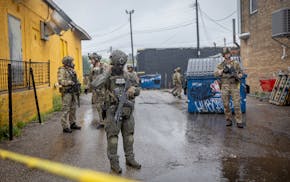ST. CLOUD – Years of declining enrollment and a chronic budget deficit prompted leaders at St. Cloud State University to cut throngs of programs and dozens of faculty in recent years.
But now that the dust has mostly settled, leaders are looking to embrace the opportunities that come with a student population that is smaller than years past, but also one that uses educational spaces differently.
"We're at this unique point where we're able to step back and say, what should our campus be for the future?" said Kelly Bartlow, facilities planning and construction director at SCSU. "We have, basically, the once-in-a-lifetime opportunity to re-envision what this campus should be."
Rapid growth in the late 20th century prompted the university to expand into the surrounding neighborhoods and erect buildings without much thought, Bartlow said: There was no outdoor quad area for studying or throwing Frisbees, building entrances faced every which way, and parking lots were squeezed into any remaining open spaces.
Leaders are now working to implement a campus design plan that will raze several unused or underused buildings in the next two decades and create more defined, park-like pedestrian spaces.
"One of our most unique features is that we're right on the Mississippi River, yet all of our buildings have their backs turned to it," said Brandon Johnson, associate vice president of academic operations and resources. "By strategically removing a couple of buildings, you can achieve a very different vibe on campus."
The plan hinges on money from the Legislature earmarked for the demolition of buildings and site repurposing at several campuses across the state.
"We're asking for $25 million as part of our operating budget request," rather than a bonding request for the demolition, said Bill Maki, vice chancellor for finance and facilities at Minnesota State, the system that oversees the seven state universities and many community colleges. "It was somewhat unprecedented for Minnesota State to ask for funds through the operating process in this area, but it's a huge priority [to] address some of our facilities backlog and deferred maintenance."
Maki said 11 institutions, including all of the system's universities — except for Minnesota State University, Mankato — have requests to raze buildings "that are past their useful life." The requests exceed $40 million.
The cost to take down a building is dependent on its size and materials, but a ballpark cost to demolish a dorm at SCSU is cited as under $3 million, Maki said.
"The $25 million, if it was fully implemented, would go a long way towards implementing this program," Maki said. "We would look at how we prioritize those across the system. Certainly, St. Cloud State has a very strong case and has gone through a very strong [planning] process."
Shuttered dorms and unused halls
SCSU's campus plan includes the removal of nine buildings in the next five years and four more in the next six to 15 years.
The first slate of buildings includes North and South Benton Halls, Sherburne Hall, Ervin House and Whitney House — all of them closed now — as well as the Kiehle Visual Arts Center, the performing arts center and the education and engineering buildings. The second slate includes Wick Science Building, Headley Hall and Stateview Apartments.
Bartlow and Johnson said they've presented the campus plan to stakeholders — including faculty, alumni, area residents and city leaders — and have heard no pushback.
But one SCSU alumnus who researched the neighborhood around campus as a graduate student is asking leaders to reconsider plans to raze historic buildings, including the Whitney House, which was built as a private mansion in the early 1900s and later hosted Eleanor Roosevelt and several Black artists who visited St. Cloud but weren't allowed to stay in local hotels.
"With its expansion over many generations, the university really grew up on top of a very architecturally and socially significant residential neighborhood and there are still artifacts of that history on campus," said Alexander Ames, who now works at a museum in Philadelphia. "I truly believe the citizens of St. Cloud and the people of Minnesota have a vested interest in [SCSU's] responsible maintenance of its historic properties."
Bartlow said none of the buildings slated for removal are on the National Register of Historic Places and that SCSU has renovated several early campus buildings in recent years, including Riverview, Lawrence Hall and Eastman Hall.
Whitney House has been empty since 2019 and was last used as an academic office.
"It's served its useful life. It was a well-lived property," Bartlow said. "But it's not designed to be an academic building, either."
Sweeping growth, a recent decline
SCSU opened in 1869 in a renovated hotel along the Mississippi River that was purchased by the Legislature. By the early 1940s, enrollment had grown to about 820 students and the campus occupied a few more buildings along the river bluffs.
The student count grew significantly in the next few decades, with enrollment reaching about 10,000 students in 1969. As the campus grew to the west, it ate up houses to make way for several academic buildings and parking lots.
By 1990, enrollment had grown to just over 17,000 — and the student count was fairly steady for the next two decades. But that number has dropped to about 10,000 students today.
The type of student has also drastically changed from traditional 18-year-olds who just graduated high school to include adults with families and full-time jobs, or students who come from high school with a handful of credits already completed.
"All of that really shifts the credit-taking behavior then on a traditional college campus," Johnson said. "They need fewer credits from us. That means we need less space."
A higher percentage of students are also part-time, meaning the head count of 10,000 students is equivalent to just about 7,300 full-year students.
"Who we are as an institution today is vastly different from who we were as an institution in the '60s and '70s when a lot of our buildings were being built," Johnson said. "They were designed to meet a specific student that really no longer is here today."
St. Cloud Mayor Jake Anderson said he plans to meet with university leaders and residents of the neighborhood surrounding campus within the next few weeks.
"I like all those concepts," Anderson said of the campus plan. "My thoughts on it are, what can we do in the neighborhood to be complementing that? So many of those houses that formerly boarded college students no longer do that. What can we do to enhance the neighborhood?"

Federal operation at Lake Street restaurant that drew protests was one of 8 across Twin Cities

MPCA intends to yank permit for St. Paul foundry accused of polluting the neighborhood

In surprise testimony, brother says Derrick Thompson was driving in crash that killed 5 Somali women

Their faces covered during Minneapolis raid, federal agents raise privacy worries

